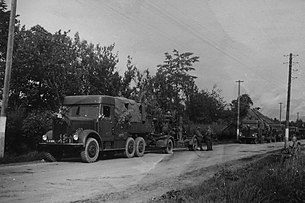
Back الانتفاضة الوطنية السلوفاكية Arabic Славацкае нацыянальнае паўстанне Byelorussian Славацкае нацыянальнае паўстаньне BE-X-OLD Slovenské národní povstání Czech Slowakischer Nationalaufstand German Slovaka nacia ribelo Esperanto Insurrección nacional eslovaca Spanish Slovakian kansannousu 1944 Finnish Soulèvement national slovaque French Insurrección nacional eslovaca Galician
| Slovak National Uprising | |||||||
|---|---|---|---|---|---|---|---|
| Part of the Eastern Front of World War II | |||||||
 Convoy of Slovak resistance army vehicles near Kelemeš (today part of Prešov) | |||||||
| |||||||
| Belligerents | |||||||
| Commanders and leaders | |||||||
|
|
| ||||||
| Strength | |||||||
| 40,000 initially, later increased to 83,000 | 18,000 initially, later increased to 78,000 | ||||||
| Casualties and losses | |||||||
| 4,200 killed, 5,000 wounded, 300 captives | 12,000 KIA and murdered in reprisals | ||||||
| History of Slovakia |
|---|
 |
|
|
The Slovak National Uprising (Slovak: Slovenské národné povstanie, abbreviated SNP) was a military uprising organized by the Slovak resistance movement during World War II in central Slovakia. This resistance movement was represented mainly by members of the Democratic Party, social democrats, and communists. It was launched on 29 August 1944 from Banská Bystrica in an attempt to resist German troops that had occupied Slovak territory and to overthrow the collaborationist government of Jozef Tiso.[1] Although the resistance was largely defeated by German forces, guerrilla operations continued until the Red Army, Czechoslovak Army and Romanian Army occupied the Slovak Republic in 1945.
In the post-war period, the Communist regime in Czechoslovakia presented the Uprising as an event initiated and governed by Communist forces.[2] Some Slovak nationalists, on the other hand, claim that the uprising was a plot against the Slovak nation, as one of its main objectives was to oust the regime of the puppet Slovak state and reestablish Czechoslovakia. In fact, many factions fought in the uprising, the largest of which were units of the Slovak Army, Democratic resistance, Communist partisans, and international forces. Given this factionalization, the Uprising did not have unambiguous popular support. Yet the participants and supporters of the Uprising represented every religion, class, age, and anti-Nazi political faction of the Slovak nation.[3][4]
- ^ "The Slovak National Uprising". ENRS.
- ^ Plevza, V. (Editor): History of Slovak National Uprising 1944 - 5. vol. Bratislava, Nakladateľstvo Pravda, 1985, pp. 488-496 (In Slovak)
- ^ Mičev, S. (Ed.), 2009, Slovak National Uprising 1944. Múzeum SNP, Banská Bystrica, p. 123 (In Slovak)
- ^ Lacko, M.: Slovak National Uprising 1944. Bratislava, Slovart, 2008 (In Slovak)
© MMXXIII Rich X Search. We shall prevail. All rights reserved. Rich X Search